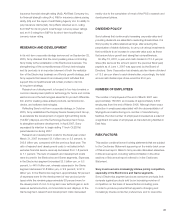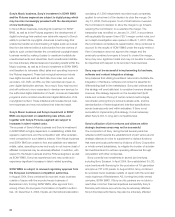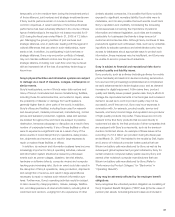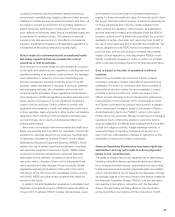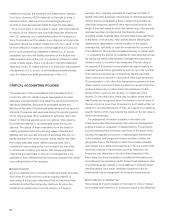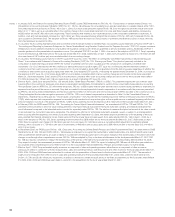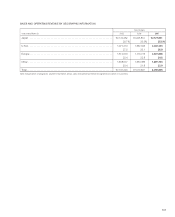Sony 2007 Annual Report Download - page 94
Download and view the complete annual report
Please find page 94 of the 2007 Sony annual report below. You can navigate through the pages in the report by either clicking on the pages listed below, or by using the keyword search tool below to find specific information within the annual report. 91
between the cost of the inventory and the net realizable value—
i.e., less reasonably predictable costs of completion and
disposal. However, if actual market conditions are less favorable
than projected and further price decreases are needed, addi-
tional inventory write-downs may be required. Additionally, as
Sony evaluates its manufacturing cost in yen while it sets its
sales prices in Euros and U.S. dollars for some products,
Sony’s results may be negatively impacted by future exchange
rate fluctuations.
■IMPAIRMENT OF LONG-LIVED ASSETS
Sony reviews the carrying value of its long-lived assets held and
used and long-lived assets to be disposed of whenever events
or changes in circumstances indicate that the carrying value of
the assets may not be recoverable. This review is performed
using estimates of future cash flows by product category (e.g.
CRT TV display) or entity (e.g. an entertainment complex in the
U.S.). If the carrying value of the asset is considered impaired,
an impairment charge is recorded for the amount by which the
carrying value of the asset exceeds its fair value. Fair value is
determined using the present value of estimated net cash flows
or comparable market values.
Management believes that the estimates of future cash flows
and fair value are reasonable; however, changes in estimates
resulting in lower future cash flows and fair value due to unfore-
seen changes in business assumptions could negatively affect
the valuations of those long-lived assets.
In the fiscal year ended March 31, 2006, Sony recorded
impairment charges for long-lived assets totaling 59.8 billion
yen, which included 25.5 billion yen for the impairment of long-
lived assets of CRT TV display manufacturing facilities to be held
and used in the U.S. in connection with certain restructuring
activities in the Electronics segment. Fair value of these assets
was determined using estimated future discounted cash flows
which were based on the best information available. The
impairment charge also included 8.5 billion yen for the impair-
ment of long-lived assets of Sony’s entertainment complex to be
held for sale in the U.S. in connection with restructuring activities
of non-core businesses in All Other. The impairment charge was
based on the negotiated sales price of the complex.
In the fiscal year ended March 31, 2007, Sony recorded
impairment charges for long-lived assets totaling 16.8 billion
yen, which included 3.6 billion yen for the impairment of long-
lived assets of CRT TV display manufacturing facilities to be held
and used in the U.S., East Asia and Southeast Asia in connec-
tion with certain restructuring activities in the Electronics
segment. Fair value of these assets was determined using
estimated future discounted cash flows which were based on
the best information available.
■GOODWILL AND OTHER INTANGIBLE ASSETS
Goodwill and other intangible assets that are determined to
have an indefinite life are not amortized, but are tested annually
for impairment in accordance with FAS No. 142 during the
fourth quarter of each fiscal year, and the assets are also tested
between the annual tests if an event occurs or circumstances
change that would more likely than not reduce the fair value of
these assets below their carrying amount. Such an event would
include unfavorable variances from established business plans,
significant changes in forecasted results or volatility inherent to
external markets and industries, which are periodically reviewed
by Sony’s management. Specifically, goodwill impairment is
determined using a two-step process. The first step of the
goodwill impairment test is used to identify potential impairment
by comparing the fair value of a reporting unit (Sony’s operating
segments or one level below the operating segments) with its
carrying amount, including goodwill. If the fair value of a report-
ing unit exceeds its carrying amount, goodwill of the reporting
unit is considered not impaired and the second step of the
impairment test is unnecessary. If the carrying amount of a
reporting unit exceeds its fair value, the second step of the
goodwill impairment test is performed to measure the amount of
impairment loss, if any. The second step of the goodwill impair-
ment test compares the implied fair value of the reporting unit’s
goodwill with the carrying amount of that goodwill. If the carrying
amount of the reporting unit’s goodwill exceeds the implied fair
value of that goodwill, an impairment loss is recognized in an
amount equal to that excess. The implied fair value of goodwill
is determined in the same manner as the amount of goodwill
recognized in a business combination. That is, the fair value of
the reporting unit is allocated to all of the assets and liabilities of
that unit (including any unrecognized intangible assets) as if the
reporting unit had been acquired in a business combination and
the fair value of the reporting unit was the purchase price paid to
acquire the reporting unit. Other intangible assets are tested for
impairment by comparing the fair value of the intangible asset
with its carrying value. If the carrying value of the intangible asset
exceeds its fair value, an impairment loss is recognized in an
amount equal to that excess.
Determining the fair value of a reporting unit under the first
step of the goodwill impairment test and determining the fair
value of individual assets and liabilities of a reporting unit
(including unrecognized intangible assets) under the second
step of the goodwill impairment test is judgmental in nature and


